All copyrights of this article are held by the author/s To cite this ...
All copyrights of this article are held by the author/s To cite this ...
All copyrights of this article are held by the author/s To cite this ...
Erfolgreiche ePaper selbst erstellen
Machen Sie aus Ihren PDF Publikationen ein blätterbares Flipbook mit unserer einzigartigen Google optimierten e-Paper Software.
Content<br />
Analysis<br />
miteinander übereinstimmt, auf der gemeinsamen Plattform versammeln,<br />
und wenn nun noch geeignete Präsentationsformen gewählt werden, die<br />
dem Nachfragenden ein zielgenaues Auffinden und eine rasche Beurteilung<br />
der Informationen ermöglichen, sind die notwendigen Voraussetzungen dafür<br />
geschaffen, das eine erfolgreiche Evolution des Wissens als Folge beschleunigter<br />
Kommunikationsprozesse stattfinden kann.<br />
59<br />
Pr<strong>of</strong>. Beat F. Schmid, mcm institute, University <strong>of</strong> St. Gallen<br />
Content Analysis<br />
Research into mass media content identifies, categorizes, describes and<br />
quantifies short-term and long-term trends. An early and most valuable descriptive<br />
trend study was that <strong>of</strong> Ernst Kris and Nathan leites in 1947. In<br />
“Trends in 20th century propaganda” in B. Berelson and M. Janowitz, eds.,<br />
Reader in Public Opinion and Communication (US: Free Press, 1947) <strong>the</strong><br />
<strong>author</strong> traced <strong>the</strong> trend in propaganda from <strong>the</strong> 1st World War (1914-18) to<br />
<strong>the</strong> 2nd (1939-45), identifying a changing style towards a less emotional,<br />
less moralistic and more truthful orientation.<br />
Content analysis serves an important function <strong>by</strong> comparing <strong>the</strong> same material<br />
as presented in different media within a nation, or between different nations;<br />
or <strong>by</strong> comparing media content with some explicit set <strong>of</strong> standards or<br />
abstract categories. On <strong>the</strong> basis <strong>of</strong> <strong>the</strong> existing body <strong>of</strong> quantitative and<br />
qualitative research, several broad generalizations may be hazarded about<br />
<strong>the</strong> content <strong>of</strong> mass communication: what is communicated <strong>by</strong> <strong>the</strong> mass<br />
media is a highly selected sample <strong>of</strong> all that is available for communcation;<br />
what is received and consumed <strong>by</strong> <strong>the</strong> potential audience is a highly selected<br />
sample <strong>of</strong> all that is communicated; more <strong>of</strong> what is communicated is<br />
classifiable as entertaining ra<strong>the</strong>r than informative or educative, and because<br />
<strong>the</strong> mass media <strong>are</strong> aimed at <strong>the</strong> largest possible audience, most material<br />
is simple in form and uncomplicated in content.<br />
Watson, James; Hill, Anne: A Dictionary <strong>of</strong> Communication and Media Studies.<br />
New York: Arnold, 1997<br />
Convergence Convergence<br />
The coming toge<strong>the</strong>r <strong>of</strong> communication devices and processes; a major fearture<br />
<strong>of</strong> <strong>the</strong> development <strong>of</strong> media technology in <strong>the</strong> 1990s. In Of Media<br />
and People (US: Sage, 1992), Everette E. Dennis writes <strong>of</strong> forms converging<br />
“into a single electronically based, computer-driven mode that has been<br />
described as <strong>the</strong> nearly universal integration <strong>of</strong> systems that retrive,<br />
process, and store text, data, sound, and image”, in short, multimedia. Dennis<br />
pounts out that convergence is far more than “<strong>the</strong> stuff <strong>of</strong> hardw<strong>are</strong> and<br />
s<strong>of</strong>tw<strong>are</strong>: it is <strong>the</strong> driving force that has spurred major change in <strong>the</strong> media<br />
industries and almost everywhere else”.<br />
Convergence has operated at <strong>the</strong> technical and operational level and at <strong>the</strong><br />
level <strong>of</strong> ownership and control. Just as individual items <strong>of</strong> hard and s<strong>of</strong>tw<strong>are</strong><br />
have been centralized into one multi-media outfit, so media procuction has<br />
been centralized into fewer corporate hands, most <strong>of</strong> <strong>the</strong>se transnational.<br />
With convergence has come a blurring <strong>of</strong> media functions: with <strong>the</strong> aid <strong>of</strong> a<br />
MODEM, <strong>the</strong> telephone permits us to surf <strong>the</strong> INTERNET or, regulation<br />
permitting, to summon up channels <strong>of</strong> screen entertainment. We can work<br />
from home, shop from home, summon up <strong>the</strong> world from home (if we <strong>are</strong><br />
lucky enough to be able to pay for <strong>the</strong> technology). Dennis says that convergence<br />
“has ushered in a united state <strong>of</strong> media, one that will continue to<br />
pose important and wrenching questions in <strong>the</strong> 1990s”.<br />
59


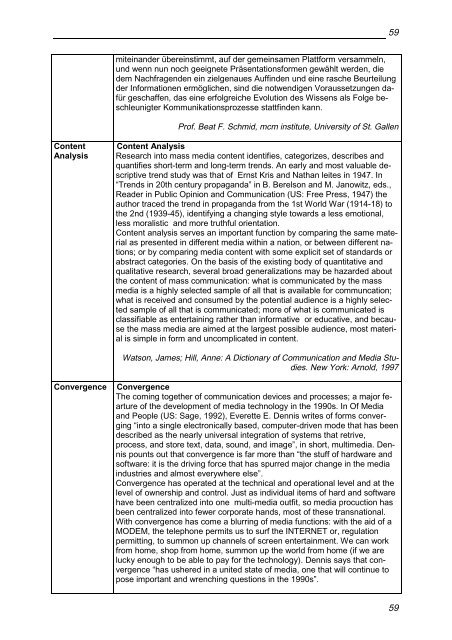






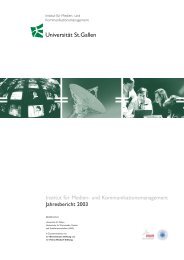

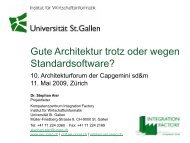
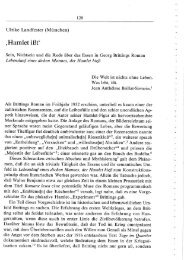
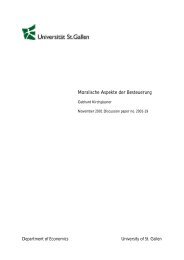

![[pdf] Blickpunkt Nr. 14/06 - Alexandria - Universität St.Gallen](https://img.yumpu.com/6499286/1/184x260/pdf-blickpunkt-nr-14-06-alexandria-universitat-stgallen.jpg?quality=85)
